Signal Iduna Park: Borussia Dortmund
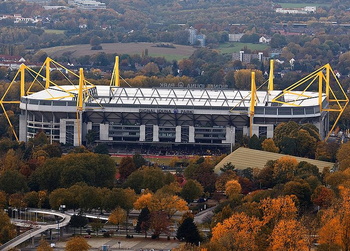
By Dirk Vorderstraße (Signal Iduna Park, Dortmund) [CC BY 2.0], via Wikimedia Commons
The home of Ballspielverein Borussia 09 e.V. Dortmund, or Borussia Dortmund as they’re better known, is officially called Signal Iduna Park. That is because the insurance company Signal Iduna Group agreed a sponsorship deal of the stadium in December 2005. Prior to the company’s decision to sponsor the stadium it was known throughout the world as the Westfalenstadion, to the extent that many supporters still call it by that name.
The Westfalenstadion is the largest stadium in Germany by capacity, with 81,359 supporters allowed into the ground for league matches in both seating and safe standing areas. For international matches the capacity is reduced to 65,829, owing to the fact that supporters can only go into the seating sections and are not allowed to stand. The huge capacity gives the ground an incredible atmosphere, with the ‘Yellow Wall’ renowned for its vibrancy and colour. It’s such an impressive sight that The Times newspaper named it the best football stadium in the world.
Stats
| Signal Iduna Park Stats | |
|---|---|
| Year Opened | 1974 |
| Capacity | 81365 |
| Average Attendance | 81305 |
| Record Attendance | 83000 (Dortmund v Schalke 2004) |
| Pitch Size | 105 x 68 (7140) |
| Former Name | Westfalenstadion, FIFA World Cup Stadium Dortmund, BVB Stadion Dortmund |
| Owner | Borussia Dortmund GmbH & Co. KGaA |
| Sponsor | Signal Iduna Group |
| Clubs Hosted | Borussia Dortmund |
| First Fixture | Dortmund v Schalke (02/04/1974) |
| Borussia Dortmund Stats | |
|---|---|
| Year Founded | 1909 |
| Nickname | Die Borussen, Die Schwarzgelben, Der BVB |
| Club Mascot | Emma the Bee |
| Rivals | Schalke 04, Bayern Munich |
| Previous Stadiums | Stadion Rote Erde |
| Kit | Yellow & Black (Home) / Black (Away) |
| Training Ground | Hohenbuschei |
| Shirt Sponsor | 1&1 |
| Team Owner | Puma SE |
| Record Goalscorer | Alfred Preissler (174) |
| Record Appearances | Michael Zorc (561) |
Signal Iduna Park Photos
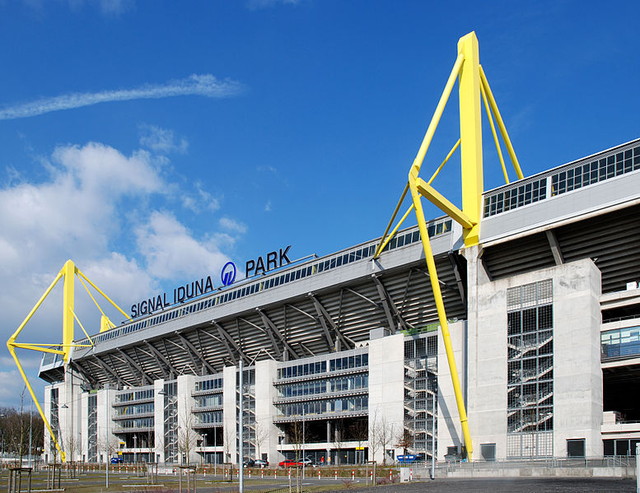
By Mbdortmund (Own work) [GFDL 1.2]

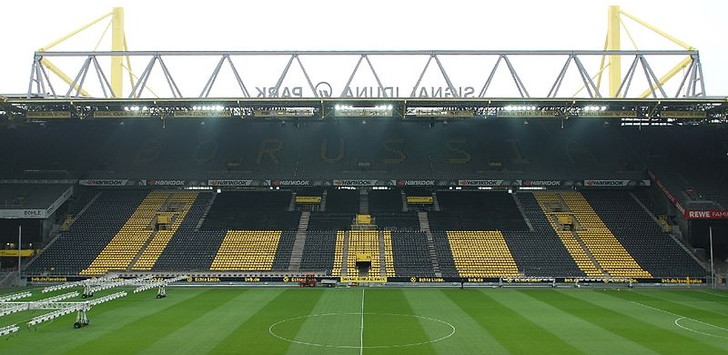
© Foto: Ra Boe / Wikipedia /
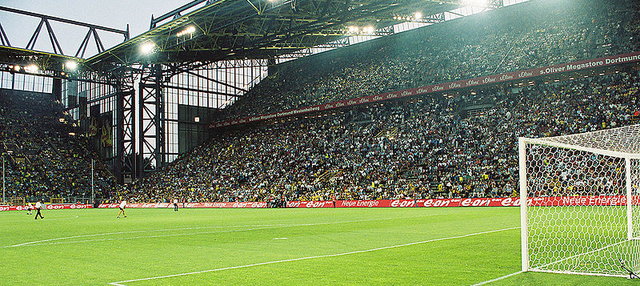
By V&A Dudush (Panoramio) [CC BY 3.0]
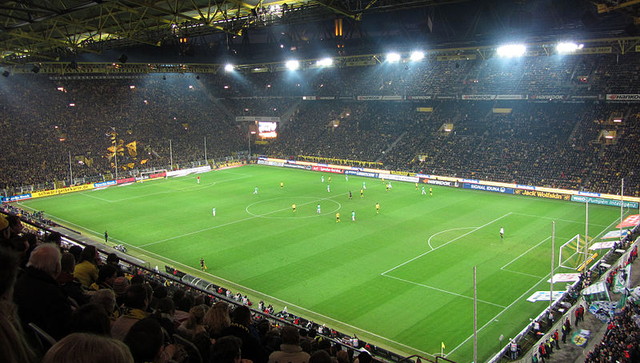
By Markus Unger (Flickr: 2012-02-26_Dortmund03) [CC BY 2.0]
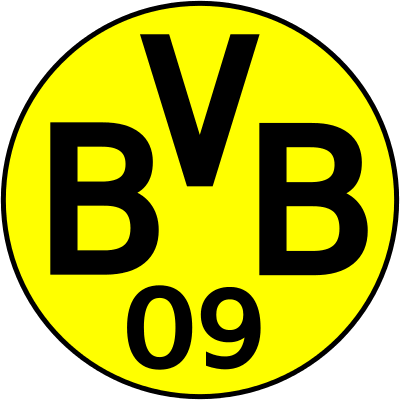
By Berni2k (open source online svg editor found on google code) [CC0 or Public domain]
Signal Iduna Park Seating Plan and Where to Sit
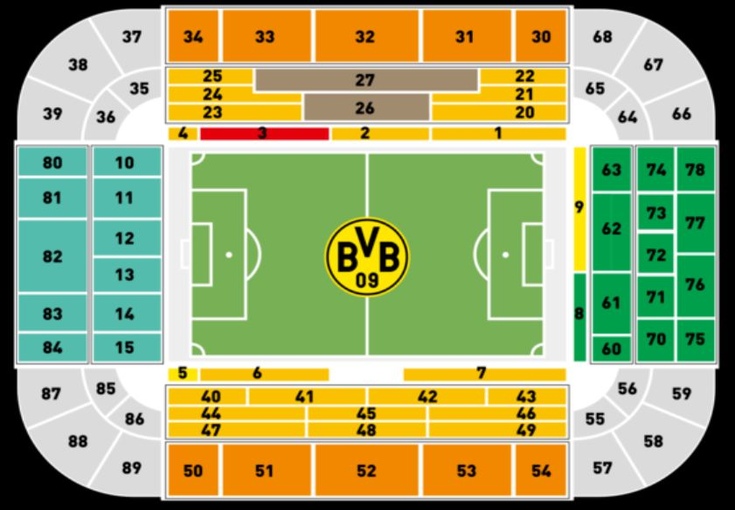
Signal Iduna Park is something of a cross between the two typical styles of stadium. There are four, distinct stands as is common in ‘English Style’ grounds, as well as filled corners that make it into a ‘Bowl Style’ more commonly found in European stadiums or newer grounds in the UK.
Here’s a bit of information about each section of the ground:
- Sud Stand – This is the most famous section of the stadium and home to the world-renowned Yellow Wall. It is the largest single-tier stand in Europe, able to hold around 24,500 fans per game. It was built with a nod towards Liverpool’s Kop stand; fitting considering both sets of fans sing ‘You’ll Never Walk Alone’ before matches.
- Nord Stand – Whilst the Sud Stand is a single-tier structure, the rest of the stadium has two tiers. There is a cantilevered roof and the incline on the stand is steep, so you’ll feel reasonably close to the pitch wherever you are.
- Ost Stand – With two tiers separated by a row of executive boxes, this stand runs along the side of the pitch and can house roughly 17,000 supporters.
- West Stand – This is considered to be the main stand in the stadium, with the changing rooms, players’ tunnel and dug-outs located here. There is also a large section of executive seating here, though the seats around them remain very affordable.
Borussia Dortmund Ticket Prices
The huge capacity of the ground means that Dortmund are able to keep their ticket prices down, with numerous price categories available throughout the ground. They offer discounted rated for disabled supporters and supporters in wheelchairs, as well as a section of the ground specifically for young persons.
The club applies a 20% surcharge for matches against Bayern Munich, FC Shalke 04 and for any Champions League matches that take place after the group stages. Here are the prices in the different categories of the stadium for normal match days:
- Category 1: €55.00
- Category 2: €45.00
- Category 3: €35.00
- Category 4: €25.00
- Category 5: €15.00
How To Get Borussia Dortmund Tickets
Despite the huge size of the Westfalenstadion, the demand for tickets still far outweighs the supply available. The best way to buy tickets for BVB games is via the club’s official ticket hotline, though there is also an online shop that you might want to turn to. You can try to buy tickets by fax as well as by snail mail. There is a shop called Fan World in Dortmund city centre where you can buy tickets, too, as well as numerous advance sales points.
Where to Buy
Getting To Signal Iduna Park
Dortmund itself is in the German federal state of North Rhine-Westphalia, so it’s not as easy to get to as, say, Paris, but it’s not exactly Siberia either. Here are some of the most typical routes that you’ll want to look into:
Train – Dortmund Hauptbahnhof isn the name of the main railway station in the city of Dortmund, with a journey from London St. Pancras International likely to take about six and a half hours. You’ll head to Brussels first before going to Kiln and then getting an ICE train through to Dortmund itself. ICE Connections are also available from places such as Berlin, Wolfsburg, Hanover, Mainz, Frankfurt, Stuttgart, Nuremberg and Munich. Once in Dortmund you’ll want to get a regional train to Signal Iduna Park Station or the underground to Westfalenhalle/Stadion.
Bus – It’s definitely easier to get the train, underground or tram to the ground, with as a bus from the main train station to the ground will take over an hour to complete its journey, with three stops along the way. There’s plenty of information on the journeys to take in the city itself, though, so keep your eye out for tourist information stalls if you’re determined to get the bus.
Car – If you’re driving from the Noth then take the A1 to the Dortmund-Unna junction before getting on the A44/B1 towards Dortmund. From the East take the A2 to the Dortmund-Nordost junction and switch on to the B236 to Schwerte then the B1 to Dortmund. From the South you’ll want the A45 to the junction for Dortmund-Süd, then get onto the B54 towards Dortmund. Finally from the West you’ll want to take the A40/B1 towards the city.
By Air – Dortmund Airport is about 25 minutes away from the city if you take the Airport Express. It’s the place low cost carriers head to. Meanwhile Dusseldorf Airport is the larger airport designed for international, long distance carriers. It’s about 45 minutes away by train.
Taxi – A taxi from Dortmund Hauptbahnhof to the ground will set you back around €15 and the journey will take just over ten minutes, depending on traffic.
Parking Near Signal Iduna Park
There are over 10,000 parking spaces available in the area around the ground as well as at Westfalenhalle. They cost an extortionate €24 per car though. The club also operates numerous park & ride possibilities that you might want to explore.
Useful Resources
Signal Iduna Park Hotels
Dortmund isn’t one of the most glamorous German cities, but it’s still well worth a visit. Here are some of our favourite hotel options you might want to consider:
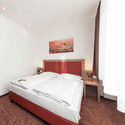
Novum Hotel Excelsior - £50+
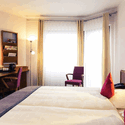
Mercure Hotel Dortmund Messe & Kongress - £70+
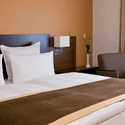
Steigenberger Hotel Dortmund - £100+
Pubs and Bars Near Signal Iduna Park
The Germans are renowned for their beer halls and places to go for a drink or a bite to eat. Here are some of the best ones in town:
Strobels Bar
Hubert's
Brauhaus Wenkers
Facilities
The Westfalenstadion is known to the club’s fans as ‘The Temple’ for a reason, it really is an excellent place to visit. The views from pretty much everywhere in the ground are excellent, for starters. There are plenty of places to buy food and drink, large concourses and modern, surprisingly pleasant toilets.
Hospitality
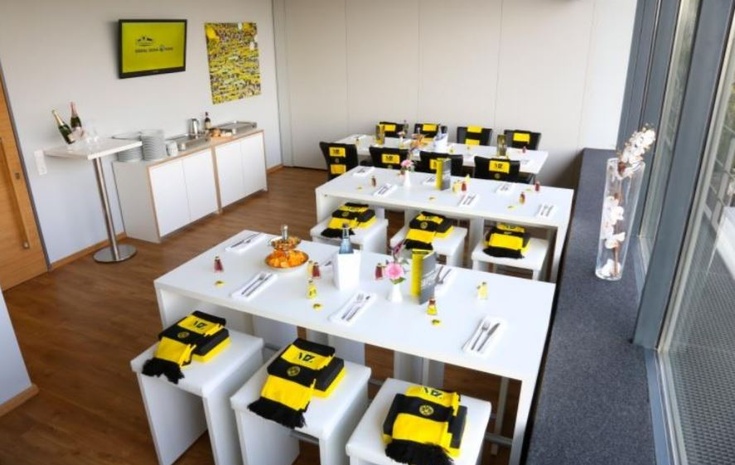
There are a number of different hospitality options at Signal Iduna Park. The stadium is huge and varied so the packages available reflect that fact. The HUAWEI Conference Center, for example, promises seats in the Nord Stand, a delicious meal and a reserved table in the VIP area. There’s also the Unilever Food Solutions Lounge that offers similar things, such as food and access to a VIP section, but in a lounge that is located in the Sud Stand.
The thing that separates BVB from most other clubs as far as their hospitality is concerned, however, is the ability to spend the afternoon on the club bus. You can get picked up, driven around Dortmund on a city tour, taken to the city’s brewery before going to watch the game. What an amazing experience.
Private Hire
When not hosting over 80,000 fans to watch Dortmund games, Signal Iduna Park is available to host any number of private events. From conferences and presentations through to parties and job fairs, there’s virtually no event you’ll want to host that the Westfalenstadion won’t be able to handle. You can even get married at the ground, should you wish to.
Stadium Tours & Museum
There are so many different tour packages here that it’s nestly a little bit ridiculous. A standard guided tour of Signal Iduna Park lasts about 90 minutes and is an excellent experience for any football fan. You’ll get to go to places that are normally reserved for special guests or people who work at the club, such as the players’ tunnel and the pitch side area. You’ll also get to stand on the famous ‘Yellow Wall’, an opportunity not to be missed.
It will cost you €12 – €15. You’ll also get to see the press room, the VIP area and the stadium prison, known as ‘Red Earth’. Tours run on a regular basis, so unless you’re there on Christmas Day or the like then there’s a good chance that you’ll get to see behind-the-scenes of the Westfalenstadion.
You can also visit the Borusseum, which is the name of the museum located inside the Westfalenstadion and is dedicated to the history of Borussia Dortmund. Adorned with numerous trinkets and pieces of memorabilia from the club’s past, the Borusseum is well worth a visit if you’re in Dortmund. It is open from Monday to Sunday 10am until 6pm or from 10am until the start of the game on match days.
About Borussia Dortmund
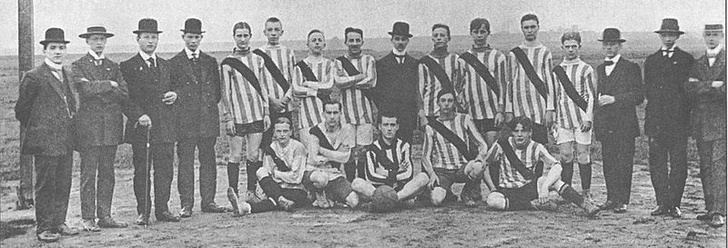
Borussia Dortmund, also known as BVB, is technically a membership based sports club that has over 115,000 members. That means that they are the third largest sports club in all of Germany by membership numbers. The club was founded in 1909 by eighteen footballers who were unhappy with Trinity Youth, the church sponsored club where they had previously played their football. Borussia is actually the Latin for Prussia, but rather than being an intellectual addition to the club’s name it was instead taken from the nearby Borussia brewery in Dortmund.
The Bundesliga was formed in 1963, with Dortmund earning their place in the new league by winning the last national championship held before it was formed. They have won the top-tier championship in Germany eight times and have finished as runners-up six times at the time of writing. They’ve won the German Cup three times and the DFB/DFL Supercut five times. In Europe they have won the UEFA Champions League once, the UEFA Cup Winners’ Cup once and finished as runners-up in the UEFA Cup twice.
Signal Iduna Park History
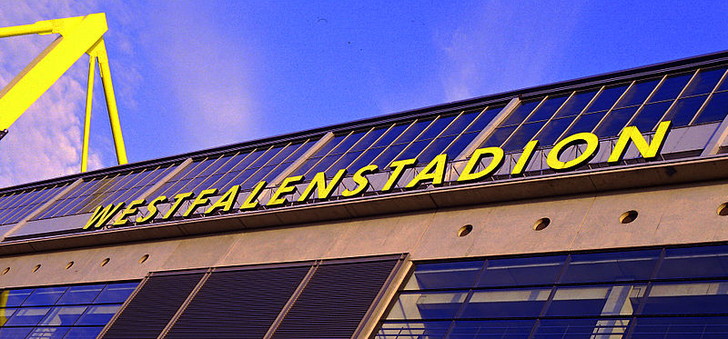
Dortmund used to play their games in the Stadion Rote Erde, but the ever-increasing popularity of the club in the 1960s meant that it wasn’t a sustainable option for the club moving forward. It’s still in existence, however, and is used by the Borussia Dortmund II team instead. Even with the increased number of supporters wanting to watch BVB play neither the club nor the city could afford to build a new stadium. In 1971, however, Cologne withdrew its plans to host games for the 1974 World Cup and Dortmund was selected instead. The moneys that had be allocated to the building of a new stadium in Cologne were therefore moved over to Dortmund, meaning a new stadium was affordable.
The ground has undergone numerous transformations over the years, mainly for the purpose of increasing its capacity. The most recent expansion came in 2006 when it was again chosen to host a World Cup – unless you count the 5 extra seats they added in 2018. It’s not a surprise that the club keep expanding the size of the ground considering that BVB has the highest attendance of any club in the world. The ground is the largest in Germany the third largest top-flight ground in Europe, behind only Camp Nou and the Wembley. As well as two World Cups it also hosted the 2001 UEFA Cup Final, the first European final that Liverpool reached after their European suspension following the Heysel disaster.
Future Developments
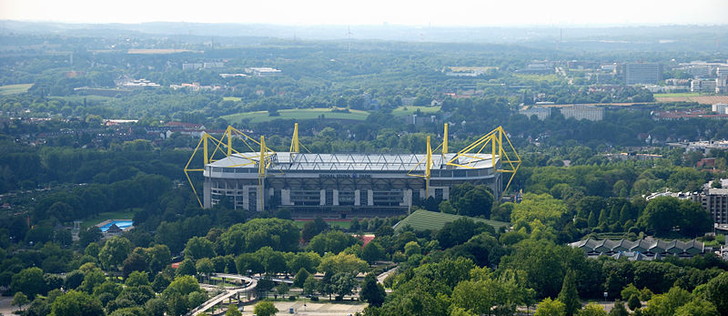
Plans for a range of improvements were in the early stages from 2018, but the pandemic put the brakes on them. They were finally completed in 2024, with modernisations to the interior, multimedia screens throughout, pitch renewal, and renovation of the roof beams among the works. As things currently stand there are no specific plans to develop the Westfalenstadion any further.
